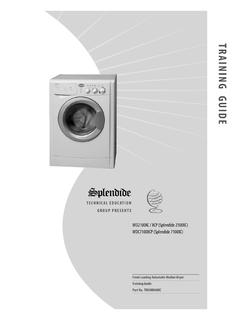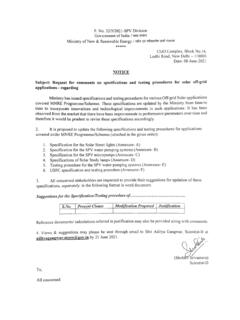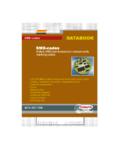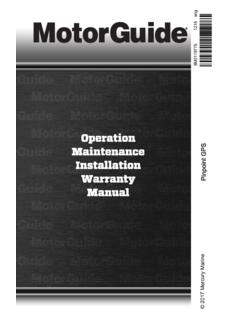Transcription of DEPARTMENT OF DEFENSE STANDARD PRACTICE - Mil-Std-130
1 NOT MEASUREMENT SENSITIVE MIL-STD-130N 17 December 2007 SUPERSEDING MIL-STD-130M w/Change 1 15 June 2007 DEPARTMENT OF DEFENSE STANDARD PRACTICE IDENTIFICATION MARKING OF MILITARY PROPERTY AMSC N/A AREA SESS DISTRIBUTION STATEMENT A. Approved for public release, distribution is FOREWORD STANDARD is approved for use by all Departments and Agencies of the DEPARTMENT ofDefense (DoD). issue of Mil-Std-130 continues to provide evolving clarification, increased insight andguidance regarding implementation of Machine-Readable Information (MRI) for itemidentification marking and automatic data capture.
2 MRI provides a valuable tool for life-cycleasset management from acquisition through manufacture to logistics and final , the use of MRI may not be suitable or adequate for every item identification application of Human Readable Information (HRI) in combination with MRI and free textinformation item identification marking in lieu of MRI is still necessary for many end users ofthe identified item. Finding the most effective use of both marking protocols, either singly or incombination, is the prime responsibility of the acquiring STANDARD provides the criteria by which product designers develop specific itemidentification marking requirements.
3 Product designers must include in product definition datathe specific requirements as to marking content, size, location, application process, and anyrequired marking materials that will be part of the deliverable item. Simply stating in theproduct definition data that the marking be in accordance with this STANDARD is not sufficient forinitial design, development and manufacture or subsequent production and procurement ofreplenishment spare activities must also properly apply this STANDARD in their contractual with product designers, simply stating that items produced under a contract shall be markedper Mil-Std-130 is not sufficient.
4 They must clearly state that item identification marking isrequired and that development of specific item marking requirements be based on the criteriaprovided in this provided in Section 3 and abbreviations provided in Appendix A and usedthroughout this STANDARD are oriented primarily towards the product designer s use of prevailingengineering documentation terminology. Some conflict with terminology applied throughout theAutomatic Identification Technology disciplines may occur.
5 Every effort has been made toascertain potential conflicts and provide clear definitions for application in this STANDARD and tocite the published source of existing definitions , suggestions, questions on this document should be addressed to 754 ELSG/ILMT,4170 Hebble Creek Rd., Bldg 280, Door 15, Wright-Patterson AFB OH 45433-5653, or e-mail Since contact information can change, you may want to verifyaddress information currency using the ASSIST Online database at MIL-STD-130N CONTENTS 1 1 1 Application 1 Application and tailoring.
6 1 2. APPLICABLE 2 General .. 2 Government Documents .. 2 Specifications, standards, and 2 Other Government documents, drawings, and publications .. 2 Non-Government 3 Order of precedence .. 6 Acronyms used in this STANDARD .. 6 Acquiring activity .. 6 Acquisition instrument identification number .. 6 Altered, selected, source control, or vendor controlled 6 6 Commercial and Government Entity (CAGE) code.
7 6 Commercial off the shelf (COTS) item .. 6 Current design activity (CDA).. 7 Data area 7 Data 7 Data Identifier (DI) .. 7 Data qualifier ..7 Data Universal Numbering System (D-U-N-S) .. 7 Design Activity .. 7 Design Activity Identification (DAI).. 7 Document ..7 DoD Activity Address Code (DoDAAC) .. 7 Electrostatic Discharge Sensitive (ESDS) Items .. 7 Electronic Serial Number (ESN) .. 7 Enterprise Identifier (EID).
8 8 Free text .. 8 Group ..8 GS1 .. 8 Human-readable information (HRI) .. 8 Human-readable interpretation .. 8 Human translation .. 8 Issuing Agency Code (IAC).. 8 Item .. 8 iii MIL-STD-130N CONTENTS Item identification .. 9 Item unique identification (IUID) .. 9 IUID equivalent .. 9 Label .. 9 Lot or batch Machine-readable information (MRI) marking.
9 9 Manufacturer (MFR).. 9 Manufacturer s 9 National stock number (NSN) .. 9 NATO Commercial and Government Entity (NCAGE) Code ..9 Nomenclature .. 9 Original design 10 Part .. 10 Part or Identifying number (PIN)..10 Selected items .. 10 Serial number .. 10 Set .. 10 Source control items .. 10 Special characteristics .. 10 Subassembly.
10 10 Supplier .. 10 Text element identifier (TEI) ..10 Unique Identification (UID) .. 10 Unique item identifier (UII).. 10 Unique item identifier (UII) data 10 Unit .. 11 Unit pack .. 11 .. 11 military property .. 11 11 Vendor item controlled 11 Verification ..11 Warranty ..11 4. GENERAL 11 Methods of applying .. 11 Location, size, and 12 Permanency and 12 Identification plates, identification tags, and identification bands.








